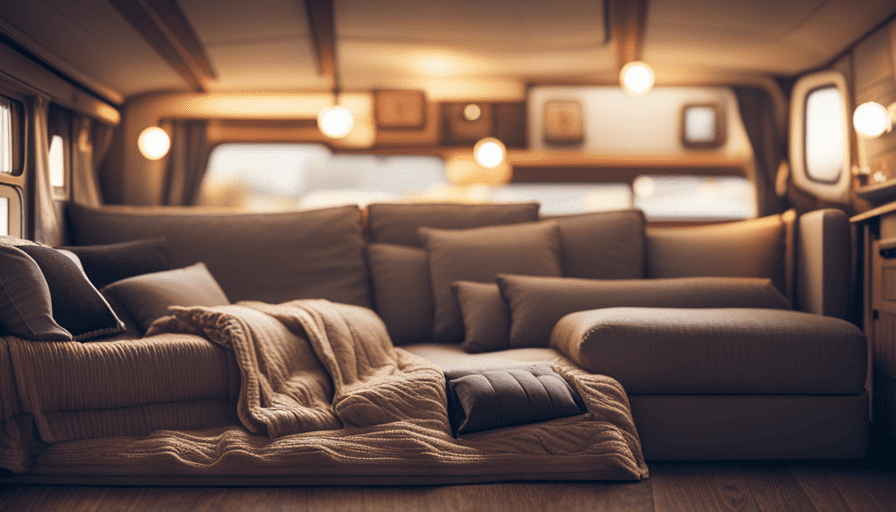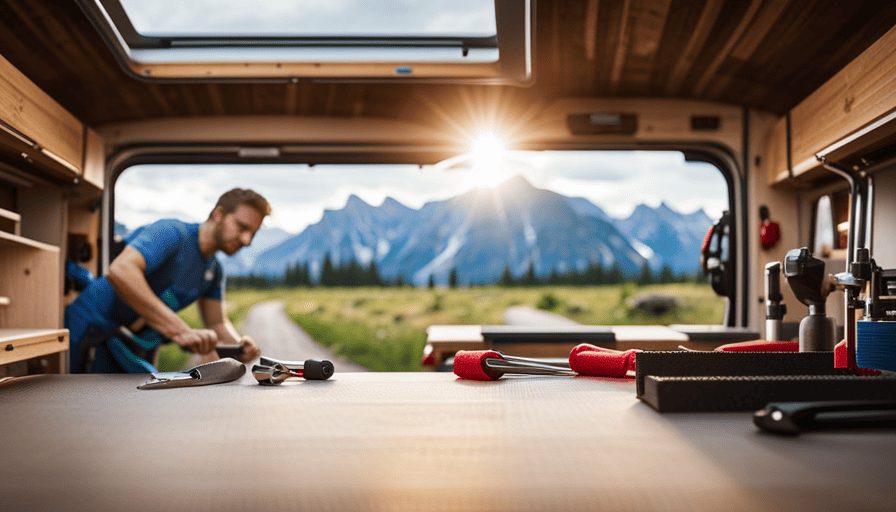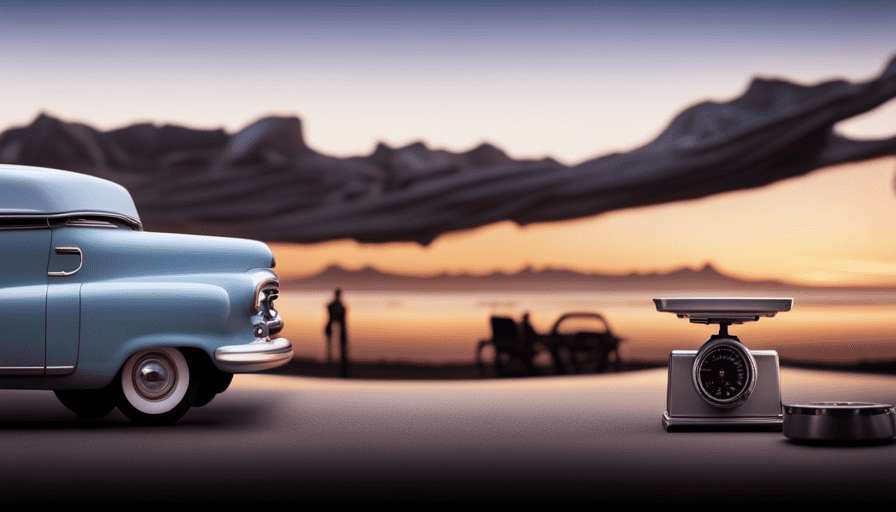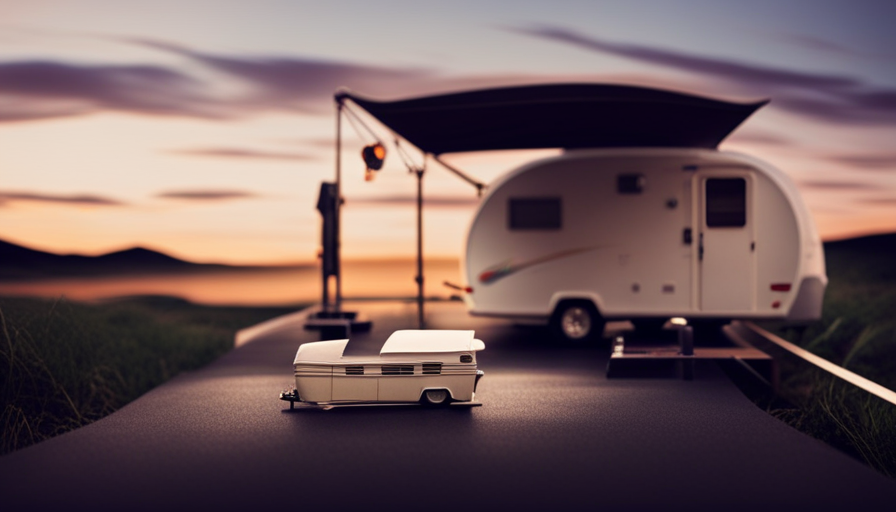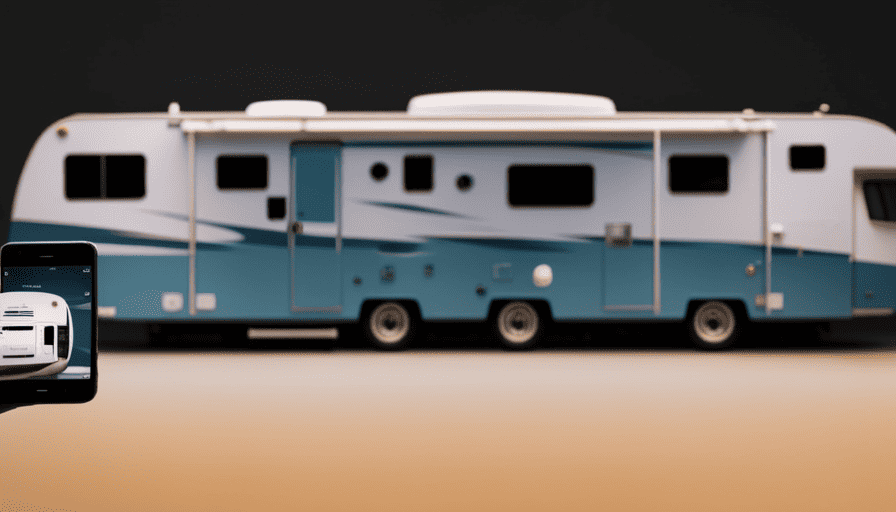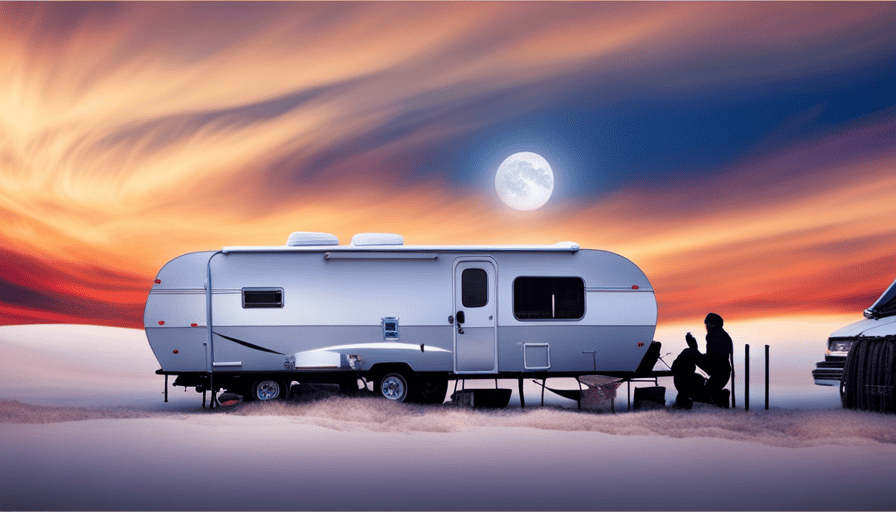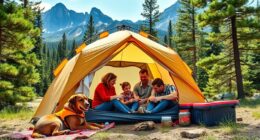Transforming a camper into a cozy space is like transforming a small space into a comfortable sanctuary. Just like a bird builds its nest, we too can create a space that exudes warmth and familiarity. Whether you’re heading out for a quick weekend getaway or fully embracing a nomadic lifestyle, there are simple ways to make your camper feel like a home away from home.
By choosing bedding and pillows that are soft and inviting, adding personal touches through decorative accessories, and creating an organized kitchen space, you can instantly elevate the coziness factor. Utilizing space-saving storage solutions, incorporating soft lighting, and setting up outdoor furniture will make your outside space just as inviting as the inside. And don’t forget to create a relaxing lounge area for entertainment and a bedroom retreat with curtains or dividers. With the right Wi-Fi and entertainment options, you can even stay connected to the outside world.
So, let’s dive in and learn how to make your camper feel like a warm and welcoming haven.
Key Takeaways
- Choose cozy bedding and pillows to create a comfortable atmosphere in the camper.
- Incorporate personal touches through decorative accessories to make the space feel more like home.
- Utilize space-saving storage solutions in the camper kitchen to keep everything organized.
- Maximize space by using foldable furniture and other space-saving techniques.
Choose Cozy Bedding and Pillows
Make sure you’ve got some soft and snuggly bedding and pillows to create a cozy oasis in your camper.
After a long day of exploring and adventuring, there’s nothing better than crawling into a comfortable bed that feels like home. When choosing cozy bedding, opt for materials that are warm and inviting, such as flannel or fleece sheets. These materials provide a soft and plush feel that’ll instantly make you feel at ease.
Additionally, consider investing in a high-quality mattress topper to add extra cushioning and support to your bed.
To enhance your sleeping experience, don’t forget about the importance of comfortable pillows. Look for pillows that offer the right balance of softness and support, ensuring a restful night’s sleep. Memory foam pillows are a popular choice as they conform to the shape of your head and neck, providing personalized comfort.
For added coziness, consider layering different types of pillows, such as a fluffy down pillow and a firm memory foam pillow, to create the perfect combination for your needs.
By choosing cozy bedding and comfortable pillows, you’ll transform your camper into a haven of relaxation and tranquility.
Now, let’s move on to the next section where we’ll explore how to add personal touches with decorative accessories.
Add Personal Touches with Decorative Accessories
Enhancing the camper’s ambiance with personal decorative touches will create a cozy and familiar atmosphere. Personalizing your space is essential to make a camper feel like home.
Here are three decorative accents that will add a personal touch to your camper:
-
Wall art: Hang up your favorite paintings, photographs, or posters to bring a touch of your personality into the space. Choose lightweight frames or adhesive wall decals to avoid damaging the walls.
-
Throw pillows and blankets: Adding soft and comfortable pillows and blankets will instantly make your camper feel cozy. Choose fabrics and patterns that reflect your style and make you feel at home.
-
Plants: Bringing a touch of nature inside your camper can make a big difference. Opt for low-maintenance, small plants that thrive in indoor environments. They’ll not only add a decorative touch but also improve air quality.
By incorporating these personal decorative touches, you can transform your camper into a space that feels like your own.
Now, let’s move on to creating a functional and organized kitchen space.
Create a Functional and Organized Kitchen Space
To truly enjoy your camper experience, it’s important to ensure your kitchen is functional and organized. In a small space like a camper, maximizing counter space is essential. One way to do this is by using multi-purpose items. For example, a cutting board that also doubles as a serving tray or a collapsible colander that can be used for washing and draining food.
Additionally, consider incorporating versatile storage solutions. Utilize hooks or magnetic strips to hang utensils or small pots and pans, freeing up valuable drawer space. Opt for stackable containers or nesting bowls to save space when storing food. Another great tip is to use vertical space. Install shelves or hanging baskets on the walls to hold spices, condiments, and other frequently used items.
Lastly, don’t forget to keep things organized. Use drawer dividers or small baskets to group similar items together, making them easier to find. By maximizing counter space and incorporating versatile storage, you can create a functional and organized kitchen that feels like home in your camper.
Next, let’s explore how to utilize space-saving storage solutions without compromising on style or convenience.
Utilize Space-Saving Storage Solutions
Maximize your mobile kitchen’s efficiency with clever and compact storage solutions that seamlessly blend style and space-saving. When living in a camper, every inch of space counts, so it’s important to make the most of what you have. Here are four space-saving storage solutions that will help you keep your camper kitchen organized and functional:
-
Foldable furniture: Invest in space-saving furniture pieces that can be folded and stored away when not in use. For example, a collapsible dining table can double as a prep area and can easily be tucked away when you’re done cooking.
-
Magnetic spice racks: Save valuable cabinet space by using magnetic spice racks. These can be attached to the inside of cabinet doors or even the refrigerator, keeping your spices easily accessible and freeing up precious counter space.
-
Hanging baskets: Utilize vertical space by hanging baskets from the ceiling or walls. These can hold fruits, vegetables, or even kitchen utensils, keeping them off the countertops and creating a more organized space.
-
Over-the-sink cutting boards: Maximize your counter space by using over-the-sink cutting boards. These boards fit right over your sink, providing a convenient workspace while still allowing you to use the sink for other tasks.
By incorporating these space-saving furniture and creative storage solutions, you can create a kitchen that’s both functional and stylish in your camper. Next, let’s explore how to incorporate soft lighting for a warm ambiance.
Incorporate Soft Lighting for a Warm Ambiance
Create a cozy and inviting atmosphere in your mobile kitchen by incorporating soft lighting that’ll instantly transform the space into a warm and welcoming haven.
Soft lighting can make a huge difference in creating a comfortable and homey environment. To achieve this, consider using warm-toned bulbs or string lights to create a soft and relaxing glow. You can also opt for dimmable lights to adjust the intensity according to your preference.
When it comes to the bedroom area, cozy bedding is essential to make you feel at home. Choose bedding that’s soft and comfortable, such as plush blankets and fluffy pillows. Adding a touch of personalization with decorative pillows or a cozy throw can also contribute to the overall warmth and comfort of the space.
In addition to the lighting and bedding, using rugs and curtains can further enhance the coziness and privacy of your camper. A plush rug can add warmth to the floor and make the space feel more inviting. Curtains not only provide privacy but also soften the overall look of the interior. Choose curtains in soft and calming colors to create a soothing ambiance.
By incorporating these soft lighting tips and cozy bedding suggestions, you can create a camper that feels like a true home away from home. Use rugs and curtains to add comfort and privacy, seamlessly transitioning into the next section.
Use Rugs and Curtains to Add Comfort and Privacy
Now that we’ve learned about incorporating soft lighting to create a warm ambiance in our camper, let’s move on to another important aspect of making it feel like home – using rugs and curtains to add comfort and privacy.
When it comes to privacy options, curtains are an essential addition to your camper. They not only provide a sense of privacy but also help block out excess sunlight and create a cozy atmosphere. Opt for curtains that match your personal style and choose thicker fabrics for better insulation and soundproofing.
In addition to curtains, rugs are a fantastic way to add comfort to your camper. They not only provide a soft and cozy surface under your feet but also help reduce noise and insulate the floor. Look for rugs that are easy to clean and durable enough to withstand the wear and tear of camping adventures.
To enhance the overall comfort of your camper, consider investing in comfortable seating options. Whether it’s a plush armchair, a cozy bean bag, or a foldable futon, having comfortable seating will make your camper feel like a true home away from home.
As we continue our journey in making our camper feel like home, our next step is to make the outside space cozy with outdoor furniture.
Make the Outside Space Cozy with Outdoor Furniture
Transform the outdoor area into a cozy oasis by adding comfortable and stylish outdoor furniture. Creating a welcoming space outside your camper is essential for making it feel like home. One way to achieve this is by incorporating outdoor dining and seating options. Having a designated area for meals and relaxation will enhance the overall camping experience.
To set up a functional outdoor dining area, consider investing in a sturdy table and chairs. Look for weather-resistant materials that can withstand the elements. A two-column and three-row table, like the one below, can help you visualize the different furniture options available:
| Outdoor Dining Area |
|---|
| Table |
| Chairs |
| Umbrella |
In addition to outdoor dining, having comfortable seating options is crucial for creating a cozy atmosphere. Consider adding lounge chairs or a loveseat to provide a space for relaxation and entertainment. You can also include outdoor cushions and throw pillows for added comfort and style. By creating a relaxing lounge area, you’ll have a perfect spot for gathering with friends and family.
Transitioning into the next section about setting up a relaxing lounge area for entertainment, let’s explore how to make the outdoor space even more inviting.
Set Up a Relaxing Lounge Area for Entertainment
Enhance your outdoor space by setting up a cozy lounge area for entertainment and relaxation. Creating a dedicated area for lounging will make your camper feel like a true home away from home.
Start by selecting comfortable seating options such as outdoor sofas or reclining chairs. Make sure to choose materials that are weather-resistant and easy to clean. Arrange the furniture in a way that encourages conversation and relaxation, such as facing each other or surrounding a coffee table.
To add a touch of fun and entertainment to your outdoor lounge area, consider incorporating outdoor games. Games like cornhole, ladder toss, or giant Jenga can provide hours of entertainment for your family and friends. Additionally, hosting movie nights under the stars can be a memorable experience. Invest in a portable projector and screen, and set up a cozy seating area with blankets and pillows.
Now, let’s transition to creating a relaxing bedroom retreat with curtains or dividers. By adding curtains or dividers to your camper, you can create separate spaces for privacy and relaxation.
Create a Relaxing Bedroom Retreat with Curtains or Dividers
To create a cozy bedroom retreat in your camper, bring in curtains or dividers that’ll separate the space and provide a sense of privacy, like a warm hug on a chilly evening.
When it comes to bedroom decor in a camper, privacy solutions are key. Curtains or dividers can help transform a small, open space into a private sanctuary where you can relax and unwind after a long day of adventuring.
Not only do curtains or dividers add a touch of coziness to your camper, but they also serve a practical purpose. They can block out unwanted light, creating a dark and peaceful environment for a good night’s sleep. Additionally, curtains or dividers can help muffle sounds, creating a more serene atmosphere.
When choosing curtains or dividers for your camper, opt for fabrics that’re lightweight and easy to install. Look for designs that complement your personal style and the overall aesthetic of your camper. Whether you prefer colorful and patterned curtains or simple and neutral dividers, there’re options available to suit every taste.
Incorporating curtains or dividers into your camper’s bedroom decor is just one way to make it feel like home. By creating a private and relaxing space, you’ll be able to recharge and rejuvenate during your travels. And when it’s time to move on to the next adventure, you can easily transition to the next section about staying connected with Wi-Fi and entertainment options.
Stay Connected with Wi-Fi and Entertainment Options
Stay connected on your travels with Wi-Fi and entertainment options that’ll keep you entertained and connected to the outside world.
In today’s digital age, staying connected is more important than ever, even when you’re on the road. Having Wi-Fi connectivity in your camper allows you to easily access the internet and stay connected with friends, family, and work. Whether you need to check emails, stream movies, or research your next destination, having reliable Wi-Fi is a game-changer.
To ensure a seamless Wi-Fi experience in your camper, consider investing in a mobile hotspot or a Wi-Fi extender. These devices can boost your signal and provide a stronger connection, especially if you’re traveling in remote areas.
Additionally, many campgrounds now offer Wi-Fi access, so be sure to inquire about their connectivity options when making reservations.
When it comes to entertainment options, the possibilities are endless. Consider installing a smart TV or a streaming device in your camper, so you can enjoy your favorite shows and movies. You can also bring along a portable Bluetooth speaker for music or podcasts. If you enjoy gaming, there are even portable gaming consoles available that can provide hours of entertainment.
By staying connected with Wi-Fi and having entertainment options in your camper, you can create a home away from home that’s both comfortable and technologically advanced. So, pack your devices and get ready to enjoy all the modern conveniences while on the road.
Frequently Asked Questions
How do I choose the right bedding and pillows for my camper?
To make my camper bed more comfortable, I focus on choosing the right bedding and pillows.
For bedding, I prefer materials like microfiber or cotton because they’re soft and breathable.
As for pillows, memory foam or down alternatives work well as they provide support and comfort.
When selecting, consider the size of your camper bed and opt for bedding and pillows that are easy to clean and store.
What are some examples of decorative accessories that I can add to personalize my camper?
Looking to add a personal touch to your camper? Camper wall art is a fantastic way to showcase your style and make the space feel like your own.
From nature-inspired prints to travel-themed canvases, there are endless options to choose from.
Another great accessory is a personalized doormat, which not only adds a decorative touch but also welcomes you and your guests.
These small additions can go a long way in making your camper feel like home.
So, why not add a touch of personality to your space?
Can you provide tips on how to maximize kitchen space in a camper?
To maximize kitchen space in a camper, organization is key. Utilize vertical space by hanging utensils and pots on hooks, and install shelves or organizers inside cabinets to make the most of every inch.
Invest in compact appliances that are specifically designed for small spaces, such as a slim refrigerator or a two-burner stove. Consider collapsible or multi-purpose kitchen tools to save even more space.
With these organization tips and compact appliance recommendations, your camper kitchen will be efficient and functional.
What are some space-saving storage solutions specifically designed for campers?
Storage solutions for campers can be like superheroes for your camping gear organization. They come in all shapes and sizes, from hanging organizers that maximize vertical space to collapsible bins that neatly store your essentials.
And let’s not forget about compact furniture options like foldable tables and chairs that can easily be stowed away when not in use. These space-saving solutions are designed specifically for campers, ensuring that you can make the most of every inch in your cozy mobile home.
How can I incorporate soft lighting in my camper to create a warm and cozy atmosphere?
To create a warm and cozy atmosphere in your camper, consider incorporating creative lighting ideas for outdoor camping. String lights or lanterns can add a soft glow and create a relaxing ambiance. You can also use battery-operated candles for a cozy feel without the risk of fire.
Additionally, create a relaxing outdoor seating area by adding comfortable cushions, blankets, and pillows. This’ll make your camper feel like a cozy retreat where you can unwind and enjoy the outdoors.
What Can I Do to Make My Camper Feel More Like Home?
Making your own camper feel more like home can be achieved through small personal touches. Adding cozy pillows, throws, and curtains can create a warm and inviting atmosphere. Hang family photos or artwork on the walls, and incorporate decorative items that reflect your personal style. Utilize storage solutions and organize belongings to maximize space. Personalizing the space with cherished items can go a long way in making your own camper truly feel like home.
Can Making a Camper More Stable Help Create a Home-like Feeling?
Making a camper more stable is crucial for creating a home-like feeling on the road. Learning how to stabilize a camper can reduce rocking and swaying, making the overall experience more comfortable. Adding stabilizing jacks and leveling the camper properly can make a big difference in creating a cozy and stable living space.
Conclusion
In conclusion, transforming a camper into a cozy home away from home isn’t just achievable but also essential for a comfortable and enjoyable experience. By selecting cozy bedding and adding personal touches with decorative accessories, you can create a welcoming atmosphere. Additionally, creating a functional kitchen space and utilizing smart storage solutions will help you stay organized. Incorporating soft lighting and making the outside space inviting will enhance the overall ambiance. Setting up a lounge area and creating a bedroom retreat will provide areas for relaxation. Lastly, staying connected with Wi-Fi and entertainment options will ensure you have everything you need. Remember, even in the smallest spaces, a little attention to detail goes a long way. Happy camping!

